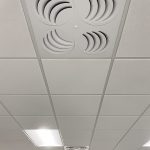Air Distribution Effectiveness
ASHRAE Standard 62.1 – 2022 – Ventilation and Acceptable Indoor Air Quality provides guidelines for acceptable indoor air quality in buildings. This standard is designed to establish minimum ventilation rates to be used in the design of HVAC systems, as well as provide guidance on the design, installation, and operation of mechanical and natural ventilation systems to achieve acceptable indoor air quality. The standard addresses various aspects of indoor air quality such as ventilation rates, filtration, and air distribution, among others.
One of the key sections of the standard is the section on Zone Air Distribution Effectiveness (Ez). The Ez Factor is used to evaluate the air distribution effectiveness in a room, and it is a ratio of the actual airflow rate at a given location to the airflow rate that would be present if the air were perfectly mixed. The Ez Factor normally ranges from 0 to 1 for Well-Mixed-Air Distribution Systems, with a value of 1 indicating perfect mixing and a value of 0 indicating no mixing. The standard provides factors for various Air Distribution Configurations in the Table 6-4 Zone Air Distribution Effectiveness (Ez). The table provides Ez Factors values greater than 1 for Stratified-Air Distribution Systems and Personalized Ventilation Systems because of their higher efficiency, however most commercial buildings use ceiling supply and return of conditioned air because of cost, ease of installation and retrofit compatibility with older systems.
A lower Ez value means that air is not being well mixed in the room, which can lead to poor indoor air quality and increased minimum ventilation rates. Inefficient air mixing can result in areas of poor air quality, such as stagnant air, higher levels of pollutants and thermal stratification, which can cause discomfort to the occupants and lead to increased health risks. The Ez Factor is used in equations to calculate the minimum ventilation rates required to maintain acceptable indoor air quality. Treating outside air (filtration, heating and cooling, humidification or dehumidification) requires a lot of energy. Consequently, a design with a lower Ez Factor will consume more energy, making it less energy-efficient.

There are several design strategies that can be used to improve the air distribution effectiveness in a room. One strategy is to optimize the airflow patterns in the room. This can be done by using CFD simulation tools, like Verified, to model the airflow patterns in the room and identify areas of poor air quality. Once the problem areas are identified, design changes can be made to improve the airflow patterns and improve the air distribution effectiveness in the room.

A third strategy is to improve the insulation of the building, which can reduce the amount of heat loss or gain from the building envelope, resulting in a more stable temperature and humidity conditions, which in turn can lead to better air distribution and thermal comfort.
One last strategy is to incorporate natural ventilation into the design. Natural ventilation can be used to supplement or replace mechanical ventilation, and can be an effective way to improve indoor air quality. By using operable windows or vents, natural ventilation can be used to bring in fresh air from the outside and improve the air distribution in the room. However, it is important to ensure that the building is properly sealed and insulated to prevent drafts and maintain a comfortable indoor environment. Some regions with more extreme climates are quite limited when it comes to using natural ventilation in efficient designs.
In addition to the strategies mentioned above, it is important to conduct regular monitoring and evaluations after the implementation of the proposed design to ensure that it is performing as expected. This can include monitoring the indoor air quality, temperature, and humidity, as well as measuring the energy consumption of the HVAC system. This data can be used to identify any issues that may arise and make adjustments to the design as needed.
In conclusion, ASHRAE Standard 62.1 is an important standard that provides guidelines for acceptable indoor air quality in buildings. The standard includes recommendations for ventilation rates, filtration, and air distribution, among other factors. Zone Air Distribution Effectiveness (Ez) is an important metric used to evaluate the air distribution effectiveness in a room and it is used to calculate the minimum ventilation rates required to maintain acceptable indoor air quality. A lower Ez value means that air is not being well mixed in the room, which can lead to poor indoor air quality and increased minimum ventilation rates. By considering the strategies mentioned above and conducting regular monitoring and evaluations, designers can improve the air distribution effectiveness in a room and achieve a balance of energy efficiency and indoor air quality.
